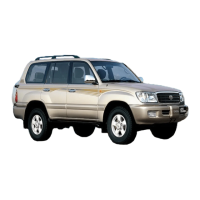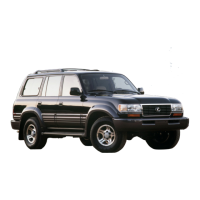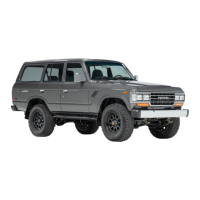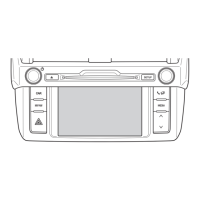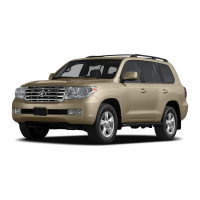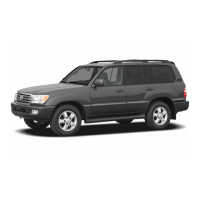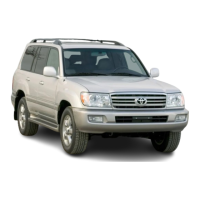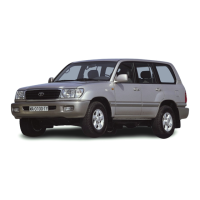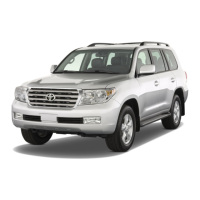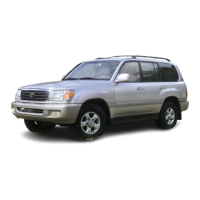
Do you have a question about the Toyota Land Cruiser 1999 and is the answer not in the manual?
| Brand | Toyota |
|---|---|
| Model | Land Cruiser 1999 |
| Category | Automobile |
| Language | English |
Provides an overview of the vehicle's instruments and controls.
Details the layout and components of the instrument panel.
Explains the layout and components of the instrument cluster.
Describes various warning and indicator lights on the instrument panel.
Covers the vehicle's keys, locking systems, and door operation.
Explains the theft prevention system involving transponder chips in keys.
Details how to lock and unlock the side doors using keys and interior knobs.
Explains the operation of the power door lock switch for locking and unlocking.
Covers adjustments and features of seats, seat belts, steering wheel, and mirrors.
Details seat adjustment precautions and the procedure for adjusting front seats.
Explains how to use the armrest and provides a notice for its care.
Describes how to adjust the second seats for access to the third seat.
Covers operation of headlights, turn signals, wipers, and defogger systems.
Details how to operate headlights and turn signals, including automatic lighting.
Explains the function of the daytime running light system.
Describes how to use emergency flashers to warn other drivers.
Covers vehicle gauges, meters, and service reminder indicators.
Explains the operation and function of the fuel gauge and low fuel warning.
Describes the engine coolant temperature gauge and what to do if the engine overheats.
Explains the oil pressure gauge and actions to take if oil pressure is low.
Covers the ignition switch, transmission operation, and parking brake.
Explains the different ignition switch positions and the steering lock mechanism.
Details the operation of the automatic transmission, including shift lock and driving patterns.
Provides instructions for normal driving with the automatic transmission.
Covers the car audio system and air conditioning controls and features.
Provides a reference to the car audio system, including basics and features.
Covers basic operation of the audio system, including turning it on/off and switching functions.
Explains how to adjust audio tone and balance settings for optimal sound.
Covers the car audio system and air conditioning controls and features.
Introduces the air conditioning system controls and their functions.
Details the various controls for the air conditioning system.
Explains the automatic operation mode for the air conditioning system.
Covers various other equipment and features of the vehicle.
Explains how to set and read the digital clock time.
Describes the outside temperature display and its function.
Explains how to use the cigarette lighter and ashtray, including safety precautions.
Details precautions for driving the vehicle off-road due to its design characteristics.
Provides guidelines for the initial break-in period of the new vehicle for optimal performance.
Covers fuel types, octane ratings, and recommended gasolines for the vehicle.
Warns against using gasolines containing MMT due to potential system damage.
Explains the function of the catalytic converter and precautions for its operation.
Provides safety precautions regarding engine exhaust fumes and system integrity.
Explains normal engine oil consumption and the importance of checking oil levels.
Mentions the type of spark plugs used and the recommendation to use only specified types.
Details the dual hydraulic circuit brake system and the function of the brake booster.
Explains the operation of the ABS system and how to use the brake pedal effectively.
Warns against high speeds on wet roads due to hydroplaning risk.
Explains the ABS warning light and conditions that indicate a malfunction.
Details the drum-in-disc parking brake system and its bedding-in procedure.
Explains the brake pad wear indicators that warn when replacement is needed.
Provides precautions for stowing luggage to ensure vehicle balance and safety.
Explains the function of the rear step bumper and its load capacity.
Explains the function of the limited-slip differential and its use.
Covers vehicle identification number (VIN) and its importance.
Shows the location of the engine number stamped on the engine block.
Explains the purpose and importance of theft prevention labels on the vehicle.
Lists pre-driving checks and adjustments for safety and comfort.
Details preparatory steps before actually cranking the engine to start it.
Provides the procedure for starting the engine under normal and flooded conditions.
Offers advice for driving in different conditions like crosswinds and hills.
Provides precautions for driving the vehicle off-road to ensure safety and prevent damage.
Lists critical precautions for off-road driving to prevent injury and vehicle damage.
Offers advice for safe driving in winter conditions, including coolant, battery, and locks.
Covers guidelines and precautions for towing a trailer with the vehicle.
Details weight limits for towing, including gross trailer and tongue loads.
Explains gross vehicle weight and axle weight ratings for safe towing.
Provides guidance on selecting and installing trailer hitches, consulting a dealer.
Explains how to determine the correct trailer ball size for a coupler.
Details how to match trailer ball height to trailer coupler height for safe towing.
Covers trailer brake requirements and the use of safety chains for secure towing.
Advises on proper tire inflation and trailer tire pressure recommendations.
Emphasizes compliance with regulations for trailer lights and their correct operation.
Recommends a break-in schedule for new vehicles or components when towing.
Highlights the need for more frequent maintenance when towing a trailer.
Lists essential safety checks to perform before towing a trailer.
Offers tips for safe trailer towing, focusing on driver error, speed, and loading.
Advises against jerky acceleration and steering to maintain vehicle control while towing.
Explains the technique for backing up a trailer, emphasizing practice and caution.
Warns about potential engine overheating when towing, especially on grades, and actions to take.
Offers tips on saving fuel and extending vehicle life through proper driving habits.
Covers simple checks and procedures when the vehicle fails to start.
Explains how to start the engine if it has become flooded due to repeated cranking.
Provides detailed instructions and safety precautions for jump-starting a vehicle's battery.
Outlines the step-by-step procedure for safely jump-starting a vehicle.
Provides instructions on what to do if the engine stalls while the vehicle is in motion.
Details steps to take if the vehicle's engine overheats, including checks and adding coolant.
Provides a step-by-step guide for changing a flat tire, including safety precautions.
Lists the necessary tools and spare tire for changing a wheel and how to store them.
Details the process of removing the spare tire from its storage location.
Explains how to block the wheels to prevent the vehicle from rolling when changing a tire.
Guides on how to safely remove the wheel ornament before loosening nuts.
Details the procedure for loosening wheel nuts before raising the vehicle.
Explains how to position the jack correctly for lifting the vehicle, including adapter use.
Details how to safely raise the vehicle using the jack for tire changing.
Covers removing wheel nuts and changing tires, including wheel reinstallation.
Explains how to reinstall wheel nuts finger-tight and then tighten them properly.
Details the procedure for safely lowering the vehicle after changing a tire.
Guides on how to reinstall the wheel ornament after changing a tire.
Covers post-tire-change checks, including air pressure and tool storage.
Explains when towing is necessary and recommends using Toyota dealer or commercial services.
Describes towing using a wheel lift truck and the use of a dolly.
Mentions towing using a flat bed truck.
Warns against using sling-type trucks for towing due to potential body damage.
Covers emergency towing procedures and precautions.
Emphasizes caution during towing, warning against sudden starts and excessive stress on hooks.
Advises using appropriate cables or chains for towing and securing them properly.
Explains how to use the shift lock override button to shift out of Park.
Details procedures for replacing lost keys and the implications for the immobiliser system.
Explains common causes of corrosion and how to prevent it through proper care.
Provides instructions and tips for washing the vehicle regularly to prevent corrosion.
Details the process for hand-washing the vehicle, emphasizing proper techniques.
Explains the process of polishing and waxing the vehicle to maintain its finish.
Provides guidance on cleaning the vehicle's interior, including carpets, upholstery, and windows.
Offers instructions and precautions for cleaning and maintaining the leather upholstery.
Covers vehicle maintenance requirements, general care, and when repairs are needed.
Details the owner's responsibility for performing regular maintenance for optimal vehicle performance.
Lists general maintenance items to be checked regularly, with a caution for engine operation.
Covers checking tires for damage and wear, and tightening wheel nuts.
Recommends rotating tires to equalize wear and extend tire life.
Advises checking for fluid leaks from various vehicle systems and correcting them.
Checks for smooth operation of doors, latches, and the engine hood's secondary latch.
Lists interior items that should be checked regularly for proper function.
Ensures all exterior and interior lights are functioning correctly and checks headlight aim.
Checks that all service indicators and buzzers are functioning properly.
Checks for changes in steering condition, such as hard steering or unusual noises.
Checks seat controls, latches, head restraints, and rear seat mechanisms for proper operation.
Verifies the proper operation and condition of the seat belt system, including webbing.
Checks the accelerator pedal for smooth operation and freedom from catching.
Checks the brake pedal for smooth operation, proper clearance, and brake booster function.
Tests brakes for proper operation and checks for pulling to one side when applied.
Checks parking brake travel and its ability to hold the vehicle securely on an incline.
Checks the selector lever's lock release button and the vehicle's security in Park.
Lists items to check in the engine compartment, such as fluids and battery.
Ensures sufficient washer fluid level and recommends appropriate fluid for cold weather.
Details how to check the engine coolant level and add appropriate coolant.
Explains how to check battery electrolyte levels and add distilled water.
Guides on checking the brake fluid level and identifying potential leaks.
Explains how to check the engine oil level using the dipstick.
Details how to check the power steering fluid level and add appropriate fluid.
Advises checking for exhaust system changes like leaks or unusual sounds.
Lists common clues indicating potential vehicle problems requiring repair.
Identifies symptoms like engine overheating or low oil pressure that need immediate attention.
Introduces the do-it-yourself maintenance section, covering its scope and precautions.
Provides a diagram and identification of key components in the engine compartment.
Shows the locations of fuse blocks and spare fuses in the vehicle.
Lists essential safety precautions and warnings for owners performing DIY maintenance.
Lists necessary parts and tools for common do-it-yourself maintenance tasks.
Covers maintenance tasks related to the engine and chassis, including fluid checks and tire care.
Covers maintenance tasks related to the engine and chassis, including fluid checks and tire care.
Details the procedure for checking the engine oil level using the dipstick, with cautions.
Provides guidance on selecting the correct engine oil viscosity and API/ILSAC grades.
Explains how to check the engine coolant level and select the correct coolant type.
Details the importance of using the correct coolant type and provides selection guidelines.
Guides on checking the brake fluid level in the reservoir and identifying potential issues.
Explains the procedure for refilling brake fluid and includes important cautions.
Details how to check the power steering fluid level and add the correct fluid.
Explains the importance of proper tire pressure and how to check it accurately.
Covers checking tire tread wear indicators and when tires need replacement.
Details how to check tires for damage, wear, and age, and when to consult a technician.
Provides guidelines for replacing tires, including size, construction, and load capacity.
Offers precautions for aluminum wheels, including checking nuts and avoiding damage.
Explains the procedure and benefits of rotating tires to equalize wear.
Advises when to use snow tires or chains for improved traction in winter conditions.
Guides on selecting the correct size and type of snow tires for the vehicle.
Explains the importance of installing snow tires on all wheels and provides installation precautions.
Details how to select the correct size of tire chains for the vehicle's tires.
Provides instructions for installing tire chains, including tightening and precautions.
Covers when to replace wheels due to damage and how to select appropriate replacement wheels.
Guides on selecting replacement wheels, emphasizing matching specifications and avoiding used wheels.
Covers maintenance of electrical components, including battery, fuses, and bulbs.
Covers maintenance of electrical components, including battery, fuses, and bulbs.
Provides precautions for checking the battery, including safety measures for handling acid and gas.
Details how to check the battery exterior for corrosion, loose connections, and damage.
Explains how to check battery fluid levels using a hydrometer and interpret the results.
Lists precautions for recharging the battery, emphasizing safety regarding hydrogen gas and charging rates.
Explains how to check for blown fuses and replace them with the correct amperage.
Describes how to use the pull-out tool to remove Type A fuses and what to do if a spare is needed.
Explains the correct procedure for installing a new fuse and using substitutes if necessary.
Addresses the issue of a new fuse blowing immediately, indicating an electrical system problem.
Guides on adding washer fluid, including the type to use and precautions.
Provides a table of bulb types and wattage, and instructions for headlight replacement.
Details the procedure for replacing headlight bulbs, including aiming.
Explains how to remove the washer inlet to access the headlight bulb and reinstall it securely.
Details the procedure for replacing front fog light bulbs.
Explains how to replace front turn signal and side marker light bulbs.
Guides on how to replace parking light bulbs.
Details the procedure for replacing stop and tail light bulbs.
Explains how to replace rear turn signal, stop, tail, and back-up lights.
Guides on how to replace license plate light bulbs.
Lists the vehicle's dimensions, weight, wheelbase, and tread measurements.
Details engine specifications, including model, type, bore, stroke, and displacement.
Covers fuel type, octane rating, and fuel tank capacity specifications.
Lists service specifications for the engine, cooling system, battery, and more.
Provides specifications for the automatic transmission, including fluid capacity and type.
Lists specifications for the transfer case, including oil capacity and type.
Details specifications for the front and rear differentials, including oil capacity and type.
Lists brake specifications, including pedal clearance, pad wear limits, and fluid type.
Provides specifications for the steering system, including wheel freeplay and fluid type.
Lists tire size, recommended tire pressures, and wheel nut torque specifications.
Details fuse types, amperage ratings, and the circuits they protect in the engine compartment.
Lists fuses located in the left side kick panel and the circuits they control.
Lists fuses of type B and the electrical systems they protect.
Lists fuses of type C and the electrical systems they control.
Covers reporting safety defects to NHTSA and understanding uniform tire quality grading.
Explains how to report safety defects to NHTSA and Toyota Motor Sales, U.S.A., Inc.
Explains the DOT quality grades for tires: Tread Wear, Traction, and Temperature.
